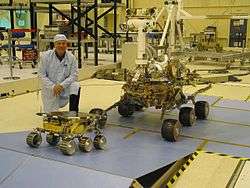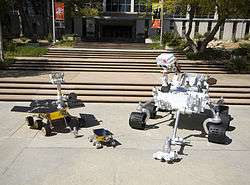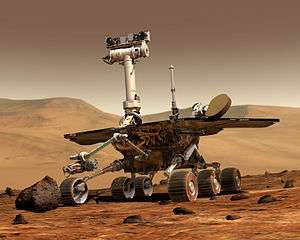Comparison of embedded computer systems on board the Mars rovers
The embedded computer systems on board the Mars rovers sent by NASA must withstand the high radiation levels and large temperature changes in space. For this reason their computational resources are limited compared to systems commonly used on Earth.[1]
In operation
Direct teleoperation of a Mars rover is impractical, since the round trip communication time between Earth and Mars ranges from 8 to 42 minutes and the Deep Space Network system is only available a few times during each Martian day (sol).[1] Therefore, a rover command team plans, then sends, a sol of operational commands to the rover at one time.[1]
A rover uses autonomy software to make decisions based on observations from its sensors.[1] Each pair of images for stereo the Sojourner rover could generate 20 navigation 3D points (with the initial software version the craft landed with). The MER rovers can generate 15,000 (nominal) to 40,000 (survey mode) 3D points.[1]
Performance comparisons
With the exception of Curiosity, each Mars rover has only one on-board computer. There are two identical on-board computers on Curiosity, which is currently operating on its redundant computer, while its primary computer is being investigated for the reasons why it started to fail.
| Rover (mission, organization, year) | CPUs | RAM | Flash | EEPROM | Operating system | CPU time available for the autonomy software |
|---|---|---|---|---|---|---|
| Sojourner Rover (Pathfinder, NASA, 1997)[1][2][3][4] | 2 MHz[5] Intel 80C85 | 512 KB | 176 KB | None | Custom cyclic executive | Not applicable to Cyclic Executives |
| Pathfinder Lander (NASA, 1997)[1] (Base station for Sojourner rover) | 20 MHz MFC (IBM RAD6000 Precursor) | 128 MB | None | 6 MB | VxWorks[6] (multitasking) | less than 75% |
| Spirit and Opportunity (Mars Exploration Rover (MER), NASA, 2004)[1] | 20 MHz BAE RAD6000 | 128 MB | 256 MB | 3 MB | VxWorks (multitasking) | less than 75% |
| Curiosity (Mars Science Laboratory (MSL), NASA, 2011)[1][7][8] | 200 MHz BAE RAD750 | 256 MB | 2 GB | 256 KB | VxWorks (multitasking) | less than 75% |
Mars Rovers
|
See also
References
- 1 2 3 4 5 6 7 8 9 Max Bajracharya, Mark W. Maimone, and Daniel Helmick (2008) (Jet Propulsion Laboratory and California Institute of Technology); Autonomy for Mars rovers: past, present, and future; published in: Computer, a journal of the IEEE Computer Society, December 2008, Volume 41, Number 12, page 45, ISSN 0018-9162.
- ↑ "Mars Pathfinder Frequently Asked Questions: Sojourner Rover". NASA/JPL. April 10, 1997. Retrieved March 27, 2009.
- ↑ Donna L. Shirley and Jacob R. Matijevic (May 10, 1997). "Mars Rovers: Past, Present, & Future". NASA/JPL. Retrieved April 18, 2009.
- ↑ Larry Lange (February 18, 1998). "U.S. plays catch-up as robots crawl into new applications". EETimes.com. Retrieved April 18, 2009.
- ↑ http://mars.jpl.nasa.gov/MPF/rover/faqs_sojourner.html#cpu
- ↑ "Wind River Powers Mars Exploration Rovers—Continues Legacy as Technology Provider for NASA's Space Exploration". Wind River. June 6, 2003. Retrieved August 28, 2009.
- ↑ "Mars Science Laboratory: Mission: Rover: Brains". NASA/JPL. Retrieved March 27, 2009.
- ↑ "BAE SYSTEMS COMPUTERS TO MANAGE DATA PROCESSING AND COMMAND FOR UPCOMING SATELLITE MISSIONS". BAE Systems. June 17, 2008. Retrieved November 17, 2008.



